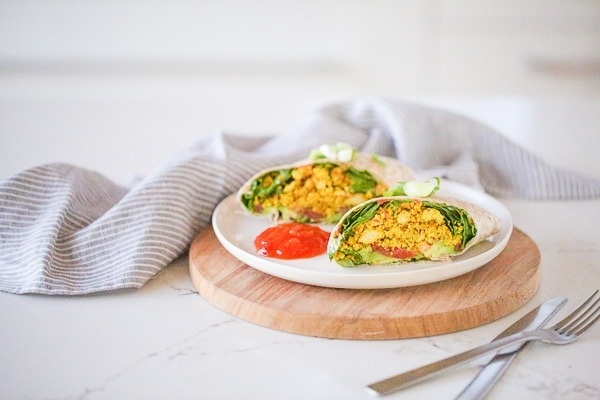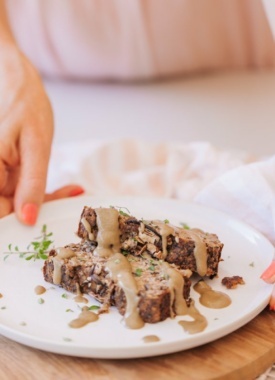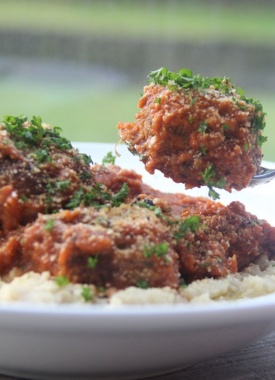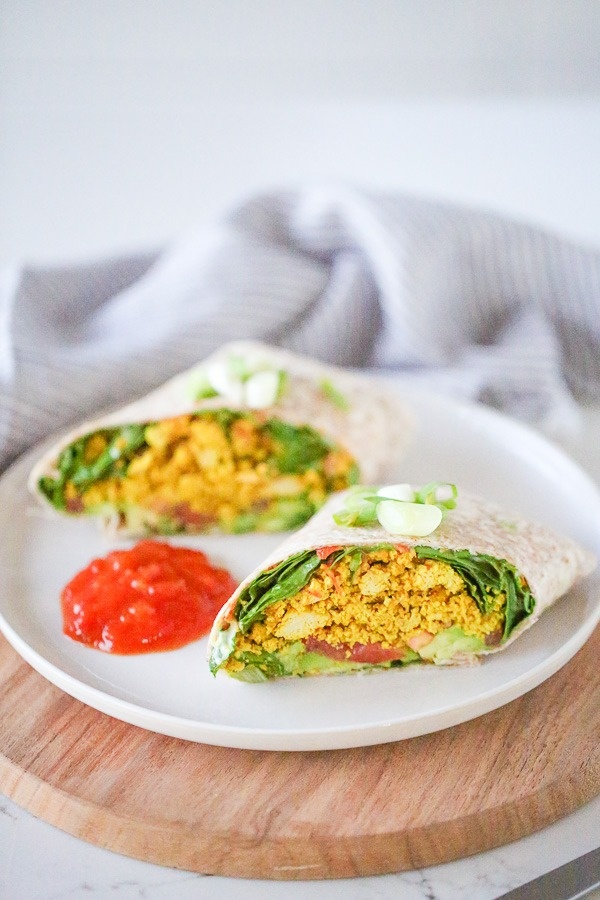
This week I’ve got a super simple, seriously tasty Bangin’ Breakfast Burrito for you. Breakfast burritos are traditionally, well, a brekky affair. But for our little fam this is more of a lunch time favourite. Think…
- 10 minutes to make
- Packed with protein
- With 3 secret ingredients that actually make it taste like eggs
Plus, I’ve also included a write up all about tofu, to answer those questions I know you have lurking (won’t it impact my hormones, will it make my men-fold grow man boobs, what about GMOs, is it even healthy?).
Dive on in below to get the answers, and try the recipe this weekend.
How to make an egg-free breakfast burrito
The flavours in this burrito are just so good – scrambled eggy tofu, creamy avo, tangy relish, dairy-free aioli, toms and greens, all lovingly enveloped in a lusciously soft wholemeal wrap. 10 minutes, and you’ve got yourself a beautifully well-balanced meal. Just toss a simple salad on the side, and you’re good to go.

Is tofu good for you?
One of the most common questions I get in clinic and from you guys, is whether or not you should consume soy products like tofu. Lots of you have been told it could cause you to experience heavy painful periods, acne, infertility, and for our men-folk, the aforementioned man boobs.
There are a few reasons for some of this misinformation:
- The estrogen question
- The GMO question
I’ll tackle each of these below.
Does soy contain estrogen?
The first premise is that soy beans contain estrogens that can act like human estrogenic hormones, thus causing a rise in blood estrogen when consumed.
Soy beans (and thus tofu) do contain estrogenic compounds, called phytoestrogens (or “plant”-estrogens). These compounds are also found in other foods such as flaxseeds/linseed, sesame seeds, broccoli, brussel sprouts, whole grains, and even nuts. They have a structural similarity to oestradiol, our primary female sex hormone, meaning they’re able to bind to estrogen receptors as our regular human estrogen might. The difference however is they actually provide a protective effect, as they’re very weak in nature (thought to be 100 to 1000 times weaker than human estrogen). As such, they hover over our estrogen receptors lightly, providing a protective barrier. This means that much stronger estrogenic compounds such as our own human estrogen, animal-based estrogens from meat and dairy, and xenoestrogens from plastics and our environment, are unable to attach and take action.
When we look at communities who do consume reasonable amounts of soy (that being traditional, minimally processed, non-GMO forms), they actually appear to be protected from estrogen-based disease. These foods include things like tofu, tempeh, soy milk made from organic whole soy beans, edamame beans, miso, and tamari. These countries who have traditionally consumed a whole food, unprocessed, soy-based diet (such as Asian countries like Japan), have the lowest levels of breast cancer, ovarian cancer, and menstrual symptoms globally.
In contrast, geographies where animal and dairy consumption is high (thus intake of animal-estrogens are high), reproductive cancer rates are much much greater, and even age of menarche is significantly earlier (girls getting periods younger, due to an early elevation of estrogen levels). It’s also worth noting that in countries like the US, most of the soy being consumed is highly processed soy protein isolates, which are used in things like cookies, breads, cakes, and crackers.

Aren’t soy beans GMO?
The next reason soy sometimes has a bad rap, is that a lot of the soy beans grown in the US are genetically modified. The reason for this, is that the vast majority (over 90%) of the soy grown globally, is actually used as animal feed. Only between 6 and 8% of soy beans are actually grown for human consumption.
As such – it’s grown quick and fast. How can we get as much soy as possible, with as little imputs as possible, and without disease. Herein come GMOs as well as pesticides. As a result, soy in the US is one of the most heavily sprayed crops, like wheat and corn (which are also mainly used for animal feed).
In New Zealand and Australia we’re lucky, as virtually all of the soy products we have available use non-GMO, organic, Australian grown soybeans. This includes almost every café I’ve been to (I always ask to see which soy milk they’re using). If you’re based in the US or elsewhere overseas, you’ll need to keep a more vigilant eye out for this, but organic options are definitely available. All you need to do is turn around the packaging and check the ingredients section. You’re looking for the words “organic whole soy beans”. If is says soy protein isolate, or soy protein, it’s best to skip it – or just use in moderation.
I’d also recommend veering away from the more highly processed forms of soy, such as soy nuggets, textured vegetable proteins, highly processed soy burgers and sausages. Or again, just have these in moderation (as your treat/takeout/quicky foods). Stick with the versions consumed by healthy Asian populations, such as tofu, tempeh, miso, edamame, tamari, and organic soy milk, for optimal health benefits.
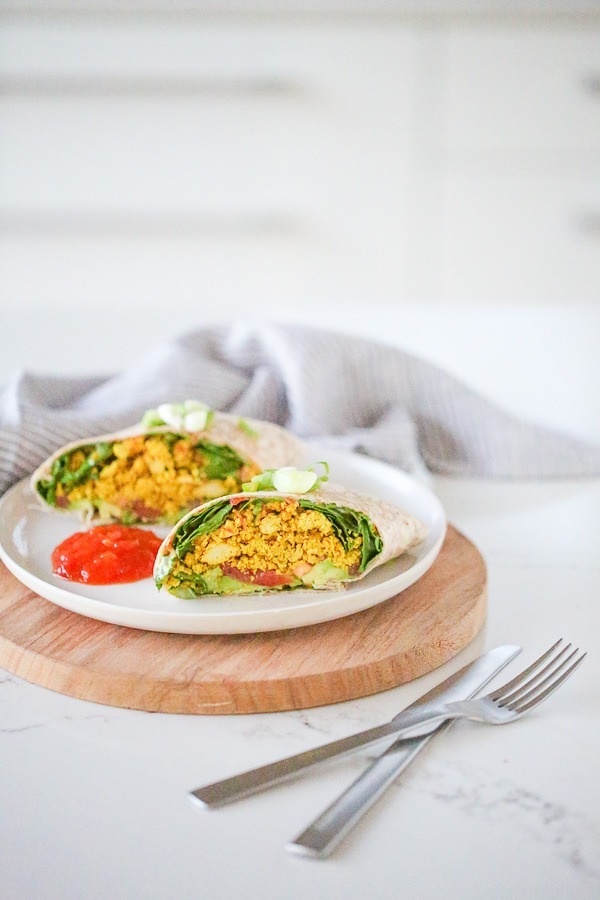
I hope that answers some of your questions on soy, and tofu. Soy products can be an incredibly healthy addition to a plant-based or even plant-leaning diet. They’re high in protein and calcium, low in saturated fat, cheap, can take on any flavour you add to them, and contain one of the best balances of complete amino acids. Give them a whirl in these burritos below!
Want more tofu ideas? Try these next
If you try this recipe, let me know! Leave a comment, rate it, and don’t forget to tag a photo #begoodorganics on Instagram. Enjoy my friend, and til next week, stay happy and well.

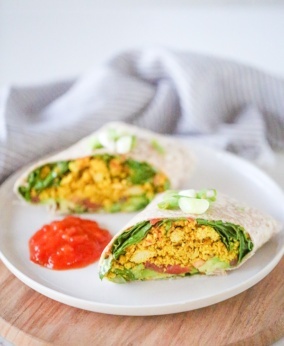
Ingredients
Eggy Tofu Scramble
- 1 tbsp coconut oil (optional)
- 275 g tofu
- 1 tbsp nutritional yeast
- 1 tsp turmeric
- 3/4 tsp black volcanic salt
- dash plant-based milk
- 1 tbsp cashew butter (optional)
To Serve
- 2 wholemeal wraps
- 2 tbsp cashew aioli
- 2 tbsp tomato relish
- 1 tomato , sliced
- 1/2 avocado , sliced
- 1 spring onion , finely sliced
- handful baby spinach
Instructions
Eggy Tofu Scramble
- Melt coconut oil in the pan (or use a good non-stick pan and skip the oil). Crumble the tofu into the pan using your hands, add nutritional yeast, turmeric, and black salt, and fry until lightly golden. Stir through the plant-based milk and cashew butter (if using) so it's creamy, then take off the heat.
To Serve
- Spread the wraps with aioli and relish, then top with eggy tofu scramble, tomato, avocado, spring onion, and baby spinach. Fold the sides in, squish the fillings down, then roll up into a burrito. Slice in half and enjoy!
Recipe Notes
- If you have a good non-stick pan you can totally get away with cooking this scrambled vegan eggy mix without oil. A cast iron pan in contrast will definitely need the extra lubrication.
- The cashew butter is optional, but makes the scramble creamy, moist, and helps it stick together rather than it becoming too crumbly or dry.

